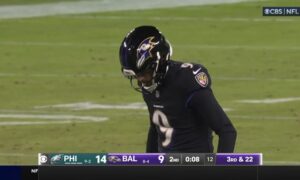The Pittsburgh Steelers got nose tackle Steve McLendon back in time for a big primetime matchup against the division rival Baltimore Ravens on Sunday night. Even if he didn’t play his best game, he did make a difference in the running game.
Admittedly, the Ravens did have to abandon the run toward the end of the game, but they still rushed 17 times on the day, excluding a two-yard quarterback scramble, holding Baltimore’s three backs to a total of 61 yards, or less than 3.6 yards per carry.
Compare that to the first matchup between the two teams, during which the Ravens’ backs rushed 30 times for 152 yards, over five yards per carry. Much of that came later in the game after McLendon was forced out with a shoulder injury that reoccurred and forced him to miss two games. 41 of Justin Forsett’s 56 yards on eight carries, for example, came on a late run with the game already out of hand.
The game between these two teams got out of hand once again, but this time it was the Ravens on the losing end, as the Steelers were up by 12 at the halfway point and concluded with a 20-point victory—the same differential, only the other way, in Week Two.
During the first game between these two teams, McLendon occasionally found himself with his hands full against center Jeremy Zuttah. He had a bit easier go of it the second time around, which included the first play of the game.
Although it was Cameron Heyward who made the play for a two-yard loss on the opening snap for the Steelers, McLendon contributed with his quick drive off the ball. the nose tackle controlled Zuttah, walking him back and forcing him into the rushing lane, leaving Forsett with nowhere to go after Heyward got past a double team.
Later on the same drive, on second and four following a six-yard carry on first down, McLendon provided us again a reminder of the benefits of having a mobile nose tackle. The Steelers highly value lateral mobility in their linemen, including their nose tackles, and their current nose tackle certainly has that.
On this particular occasion, his lateral mobility, combined with hand fighting and arm positioning, got him around Zuttah, and enabled him to swallow up the running back after just a gain of one. The Steelers forced an incompletion on third down and the Ravens had to punt.
Another advantage of a more athletic, mobile nose tackle is his ability to get into plays you wouldn’t ordinarily expect a traditional 3-4 nose tackle to do, such as this run early in the second half of the game.
On the play, the Ravens line shifted left, with Zuttah pushing McLendon to the right for the right guard to pick up. Though the guard seemed to have possibly stumbled over a foot or something, McLendon positioned himself well and used his arms to gain separation, and he was able to flow down the field to tackle the ball carrier after six yards.










